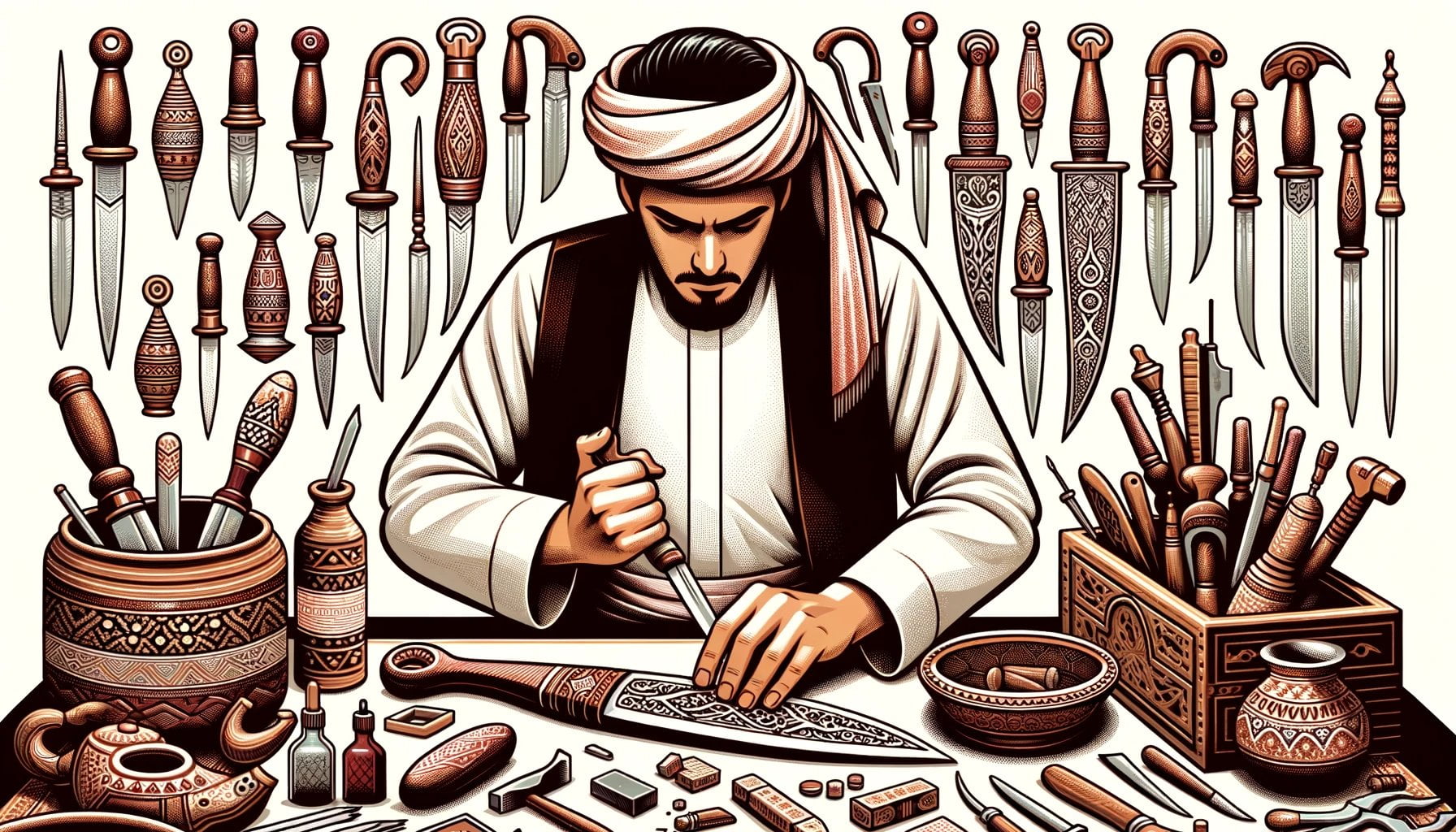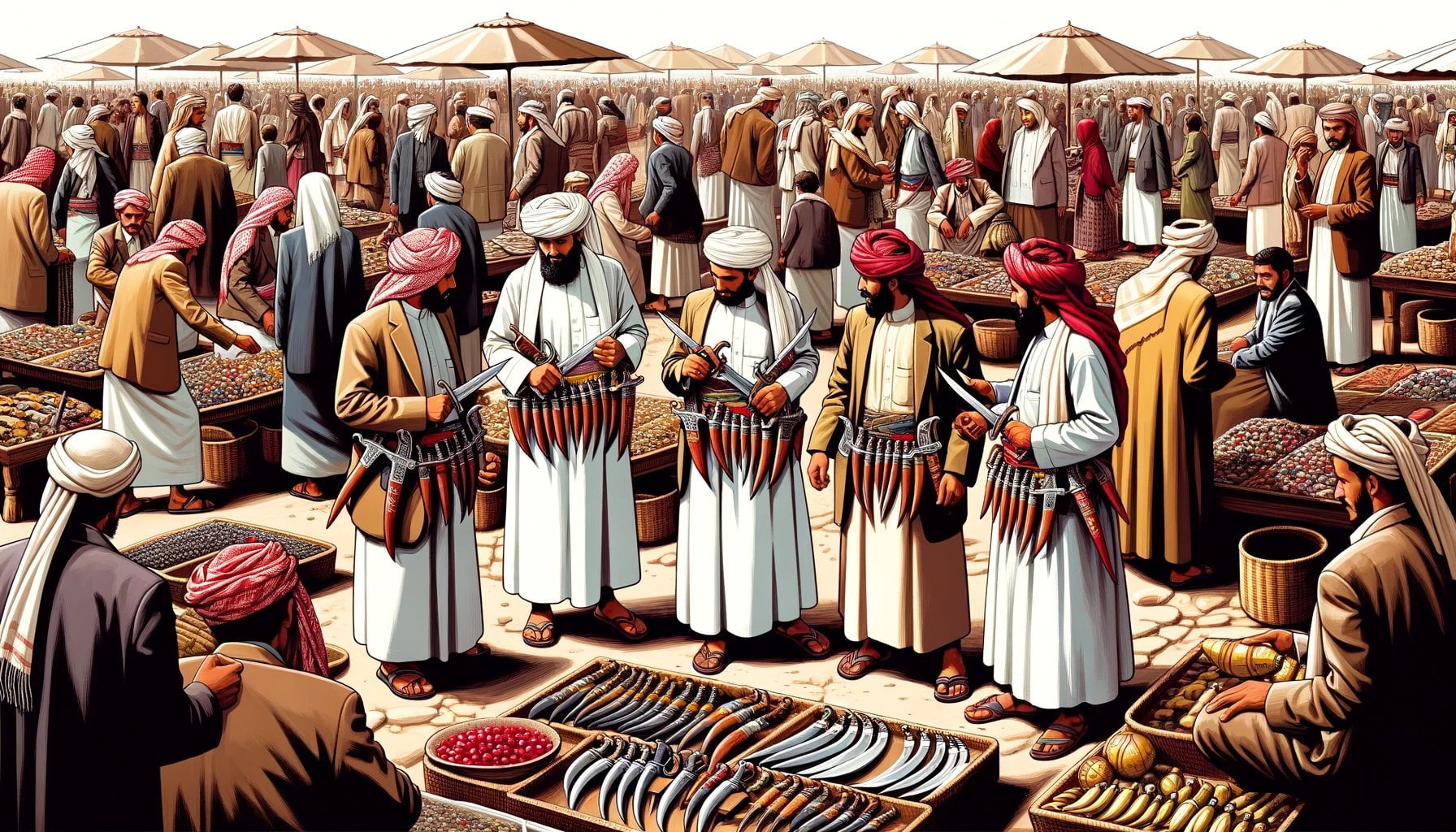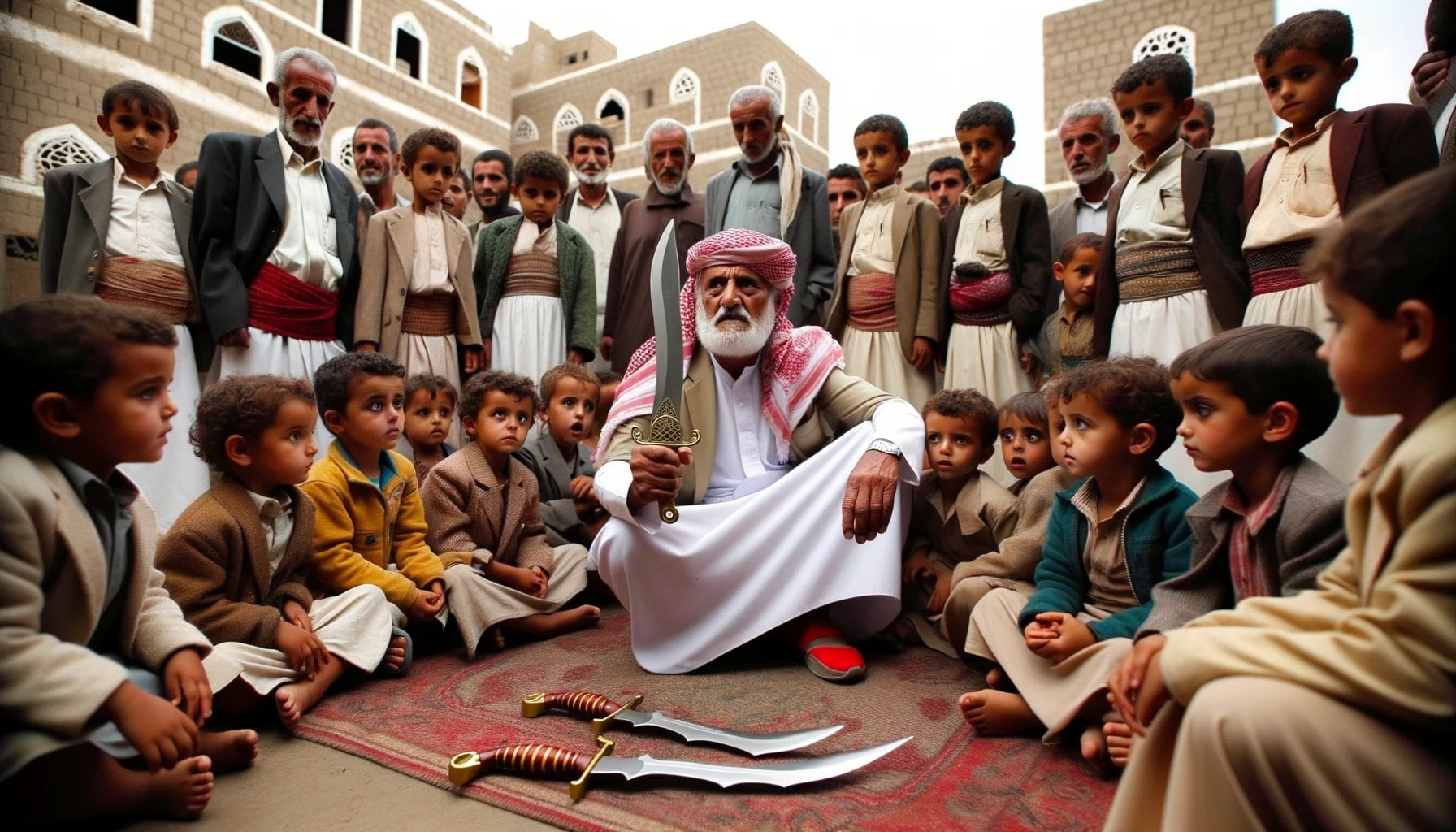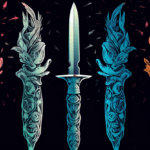Delving into the captivating phenomenon of Yemenis carrying daggers, this article aims to unravel the age-old tradition that has fascinated cultural anthropologists for centuries. Why do Yemenis carry daggers? With a deep passion for understanding Middle Eastern customs and traditions, our seasoned journalist with over a decade of investigative reporting experience will embark on a journey to decipher the historical, functional, and symbolic significance of these symbolic objects in Yemeni society. Through meticulous research and compelling storytelling, we aim to shed light on the reasons behind this enduring practice.
Why do Yemenis carry daggers?

As we explore the captivating tradition of Yemenis carrying daggers, known as jambiyas, we uncover a rich tapestry of symbolism, culture, and history. But what drives Yemeni men to proudly don these ornamental weapons? Let’s delve into the depths of this age-old tradition and unravel the reasons behind it.
A Symbol of Manhood and Status
For Yemenis, carrying a dagger is more than just a fashion statement – it is a mark of manhood and social status. In the past, daggers served as tools for combat and defense, but their significance has evolved over time. Nowadays, the jambiya is worn on the front or right side of the waist, signifying a Yemeni man’s pride, honor, and individuality. It is a tangible representation of his strength and masculinity.
Embracing Freedom and Identity
The jambiya is more than a mere accessory; it embodies Yemeni values of freedom and self-expression. By wearing a dagger, Yemeni men embrace their personal liberties and individuality. The jambiya becomes an extension of themselves, reflecting their unique identities within their society.
Unveiling the Jambiya’s Cultural Significance
To truly grasp the profound meaning behind the jambiya, we must explore its cultural significance. The daggers are often worn with a belt called al-Kibsi, adorned in vibrant gold and red colors, further amplifying their visual impact. Additionally, the jambiya’s hilt, made from various materials such as rhinoceros horn, wood, metal, ivory, or different types of horn, carries immense importance. The intricacies and design of the hilt declare the status and value of its owner.
The Blade, Sheath, and Scabbard
While the hilt holds symbolic value, the jambiya’s blade and sheath also contribute to its allure. The blade, typically made of steel, including damascus or wootz steel, represents the weapon’s strength and historical significance. As for the sheath, known as “Asib,” it can be crafted from wood covered with metal, leather, or cloth. Often embellished with silver work, semi-precious stones, or leather, the sheath exemplifies the craftsmanship and artistry inherent in Yemeni culture.
Preserving Tradition and History
Carrying a jambiya is an enduring link to Yemeni history and heritage. Despite its modern use as a symbol, the jambiya remains a functional weapon, only drawn in extreme cases of conflict. However, it is not limited to combat; the jambiya also features prominently in traditional events and dances, showcasing Yemeni pride and cultural traditions.
In conclusion, the tradition of Yemenis carrying daggers runs deep, embodying concepts of manhood, freedom, and cultural identity. The jambiya’s symbolism is intricately woven into every aspect of its design, from the hilt to the blade and sheath. By donning these ornate weapons, Yemeni men proudly preserve their history and express their unique place in society. So, the next time you see a Yemeni gentleman sporting a jambiya, remember that it represents far more than meets the eye. It is a tangible symbol of Yemeni pride, honor, and the enduring spirit of its people.
Ancient daggers have always held a mysterious allure, with their exquisite craftsmanship and historical significance. If you’re fascinated by the stories behind these exceptional weapons, then you’ll definitely want to explore our collection of ancient daggers here. Uncover the secrets of the past and immerse yourself in the rich history of these captivating artifacts.
Sociocultural Reasons Behind the Continued Practice of Carrying Daggers
The Jambiya: A Symbol of Yemeni Culture and Identity
Yemen, a country rich in history and tradition, boasts a fascinating cultural phenomenon that has endured through the ages – the carrying of daggers, known as jambiyas, by Yemeni men. These intricately designed and crafted daggers hold significant sociocultural importance, reflecting the values, heritage, and identity of the Yemeni people.
A Symbol of Manhood and Social Status
The jambiya is not merely a weapon; it serves as a symbol of manhood, freedom, and individuality for Yemeni men. Worn on the front or right side of the waist, the jambiya represents strength, courage, and honor. Its presence signifies the transition from boyhood to manhood, as well as the attainment of social status in Yemeni society.
Unveiling Tribal Background and Social Standing
Intricate carvings adorning the jambiya provide valuable insights into the owner’s tribal background and social standing. The design and materials used in creating the hilt and scabbard of the jambiya vary depending on the region they come from, showcasing the diverse tribal cultures within Yemen. These unique markings and decorative details act as a visual language, communicating the wearer’s affiliation and position within society.
Preserving Tradition and Cultural Identity
Carrying a jambiya is a deeply rooted tradition passed down through generations in Yemen, particularly among rural tribes. The jambiya serves as a tangible link to Yemeni history, preserving cultural practices and ancestral customs. Its continued presence reinforces Yemeni cultural identity in a rapidly changing world, asserting the pride and resilience of the Yemeni people.
The Presence of Noble Values
The significance of carrying daggers in Arabian culture extends beyond Yemen. Throughout ancient times, daggers have been associated with noble values such as strength, dignity, courage, and honor. The jambiya embodies these principles, serving as a constant reminder of the enduring spirit and national pride of the Yemeni people.
Conclusion
The sociocultural reasons behind the continued practice of carrying daggers among Yemenis are deeply intertwined with notions of manhood, social status, tribal identity, tradition, and cultural pride. The jambiya remains a powerful symbol that not only reflects the rich heritage of Yemen but also serves as a testament to the strength and resilience of its people. By understanding the significance of this age-old tradition, we gain valuable insights into the complex tapestry of Yemeni society and the enduring legacy of its cultural practices.
Functional Uses of Daggers in Yemeni Society
In Yemeni society, the tradition of carrying daggers, known as jambiyas, goes beyond its symbolic significance. These curved and double-edged daggers have practical functions that have been ingrained in Yemeni culture for generations. Let’s explore the functional uses of daggers in Yemeni society.
Self-Defense and Protection
One of the primary functional uses of daggers in Yemeni society is self-defense. In a society that values honor and individuality, carrying a jambiya provides a sense of security and protection. Historically, the jambiya was used by Yemeni men to defend themselves and their families from potential threats. Its design and construction make it an effective weapon for close combat situations.
Utility Tool
Aside from self-defense, daggers in Yemeni society have practical everyday uses. In rural areas, the jambiya’s sharp blade comes in handy for various tasks such as cutting ropes, hunting, preparing food, and even handling livestock. Its versatility makes it a valuable tool for Yemenis, especially those living in more remote communities where access to modern tools may be limited.
Cultural Ceremonies and Festivities
The functional uses of daggers extend beyond their practical applications. In Yemeni society, jambiyas play a significant role in cultural ceremonies and festivities. During weddings, for example, the groom often wears a jambiya as part of his traditional attire. The dagger symbolizes masculinity, honor, and heritage, and its presence adds a touch of grandeur to these special occasions.
Symbol of Tribal Identity
Furthermore, daggers serve as a visual representation of Yemeni tribal identity. Each region in Yemen has its own distinct style of jambiya, with variations in hilt design, blade curvature, and scabbard embellishments. By carrying a jambiya specific to their tribe, individuals proudly display their cultural heritage and belonging. The functional aspect of the dagger becomes intertwined with the expression of tribal identity, strengthening social connections among Yemeni communities.
Table: Functional Uses of Daggers in Yemeni Society
| Functional Uses | Brief Description |
|---|---|
| Self-Defense | Carrying a jambiya provides a sense of security and serves as a weapon for personal protection. |
| Utility Tool | The sharp blade of the jambiya has practical uses in daily tasks such as cutting, hunting, and farming. |
| Cultural Ceremonies | Jambiyas are worn during weddings and other cultural festivities, symbolizing honor and tradition. |
| Tribal Identity | Different jambiya styles represent specific tribes, allowing individuals to proudly showcase their roots. |
Through exploring the functional uses of daggers in Yemeni society, we gain a deeper understanding of the jambiya’s significance. It serves not only as a weapon and tool but also as a cultural artifact that embodies tradition, identity, and the enduring spirit of the Yemeni people. The jambiya is a testament to the rich and multifaceted nature of Yemeni heritage, where functionality intertwines with symbolism.
The symbolic meaning and cultural identity associated with dagger carrying
Carrying daggers has long been a tradition in Yemen, intertwined with the cultural fabric of its society. The act of donning these symbolic weapons holds a significance that goes beyond mere self-defense. Let’s delve into the historical, functional, and symbolic layers that contribute to the enduring presence of daggers in Yemeni society.
An Emblem of Tradition and Heritage
The jambiya, the traditional Yemeni dagger, represents more than just a weapon. It is a testament to the pride and honor of the Yemeni people. The jambiya embodies noble values such as strength, dignity, courage, and honor. Passed down through generations, it preserves Yemeni cultural practices and ancestral customs.
Symbolic Significance and Sociocultural Reasons
The jambiya holds multifaceted meanings in Yemeni society. First and foremost, it symbolizes manhood, freedom, and individuality for Yemeni men. Its design and materials provide insights into the owner’s tribal background and social standing. In this way, the jambiya showcases cultural heritage and strengthens social connections.
The Functionality Beyond Symbolism
While the jambiya carries immense symbolism, it also serves practical functions in Yemeni society. Beyond its symbolic significance, the primary purpose of daggers is self-defense, providing a sense of security and protection. Moreover, these versatile tools find utility in everyday tasks such as cutting ropes, hunting, and food preparation.
Grandeur in Ceremonies and Festivities
Jambiyas play a significant role in cultural ceremonies and festivities, adding an element of grandeur to the occasion. These ceremonial daggers symbolize masculinity, honor, and heritage, enriching the cultural tapestry of Yemeni celebrations. The style of the jambiya represents tribal identity, signifying the deep-rooted traditions within Yemeni society.
Preserving Yemeni Identity
In a rapidly changing world, carrying daggers, known as jambiyas, is a cultural phenomenon in Yemen that has endured through the ages. It serves as a reminder of the Yemeni people’s resilience and their commitment to preserving traditions, identity, and the enduring spirit that defines the nation.
Through exploring the historical, functional, and symbolic aspects of dagger carrying, we gain a deeper understanding of the significance it holds in Yemeni society. The jambiya, in all its glory, captures the essence of Yemeni culture, representing values of strength, honor, and pride. Its presence on the belts of Yemeni men serves as a powerful testament to the rich cultural heritage that continues to shape the nation.

FAQ
Q1: Why do Yemenis carry daggers?
A1: Yemenis carry daggers, specifically the jambiya, as a symbol of manhood, freedom, and individuality. It is a tradition that dates back generations and holds cultural and historical significance in Yemeni society.
Q2: What is the jambiya?
A2: The jambiya is a traditional Yemeni dagger that comes in various forms and styles, such as the ‘aseeb and thumah. It is always curved and double-edged, with differences in hilts and scabbards depending on the region.
Q3: What does the jambiya symbolize?
A3: The jambiya symbolizes masculinity and is considered a status symbol in Yemeni society. It represents pride, honor, and social status. The intricate carvings on the dagger can provide clues about the owner’s tribal background and social standing.
Q4: How is the jambiya worn?
A4: Yemeni men typically wear the jambiya on the front or right side of the waist. It is often accompanied by a specific belt called al-Kibsi, usually in gold and red colors, and a golden thumah.
Q5: Is the tradition of carrying daggers still prevalent in Yemen?
A5: Yes, despite the ongoing war in Yemen, the tradition of wearing jambiyas and preparing for Eid celebrations continues. The jambiya remains a significant cultural artifact that reflects the history and traditions of Yemen.
- SYBAU See You Baby Meaning: Gen Z Slang Evolves - July 1, 2025
- Unlock Your Inner Youth: Lifestyle Secrets for a Vibrant Life - July 1, 2025
- Decode SYBAU Meaning: Gen Z Slang Explained - July 1, 2025






